In-Depth
Making Windows 10 More Creative
UX features introduced with the Windows 10 Fall Creators Update include Microsoft's new Fluent Design, mixed reality, Android Launcher, and a video editing tool, plus mobile and multiplatform versions of Edge.
While the latest Windows 10 Fall Creators Update won't be remembered as the most significant of OS upgrades, Microsoft has added quite a few new features that users and administrators will welcome.
In addition to new management and security capabilities that have been covered extensively by Redmond magazine (see "Windows 10 Management and Security Improvements" for links to coverage), the new release, also known as Windows 10 version 1709, brings Microsoft's recent focus on taking the UX up a notch.
Windows 10 version 1709 also picks up on Microsoft's effort kicked off with the first Creators Update released in April, with a sharp new focus on making the OS more appealing to those who produce content -- ranging from professional graphic designers, video editors and those with little or no artistic, editing or production experience.
Likewise, Microsoft is looking to extend the UX of workers ranging from engineers who work with CAD software on systems with high-end CPUs and GPUs and medical professionals, to scientists, data scientists and others who want to push the limits of what a PC can now do.
Fluent Design
Perhaps the most significant addition Microsoft introduced with version 1709 was the new visual experience. Microsoft's Fluent Design System, the company's ambitious effort to bring 3-D and other modern visualization capabilities across form factors, addresses five key vectors identified by Microsoft: light, depth, motion, material and scale.
Notable new features in the Fall Creators Update also include quick access to specific people, improvements to digital input, added intelligence to Cortana and the ability to perform voice translation, OneDrive Files on Demand and support for new mixed reality headsets delivered by partners. The update also includes a video editing tool, integration with iPhones and Android phones, and improvements to the Edge browser, including added markup capabilities to books and the ability to pin Favorites to the Taskbar.
Whether the new features are enough to reverse the fortunes of the declining PC market is hard to predict, but Microsoft's realization that Windows isn't the only game appears to be motivating the company to emphasize the UX like it never has before.
Rising Demand
Microsoft's Personal Computing Group is starting to show increasing signs of improved demand. While it's premature to suggest that it has translated to increased demand, last quarter the group outperformed expectations. Though relatively flat compared to the same period last year, performance was better than expected -- to the tune of $500 million in revenues, totaling $9.4 billion. Notably, that outperformed the PC market.
By no means does that suggest that Windows is about to go on a tear in the coming year, but it also is a signal to Microsoft that the death of Windows has long been exaggerated. Failing to make Windows attractive to the next generation of computing users would only hasten its demise and become a legacy platform.
Life After Windows Phone
At the same time, the recent news that Microsoft has curtailed development of Windows on phones might have some loyalists wondering about its commitment to its strategy of providing the OS on PCs, mobile devices, Xbox and embedded systems. However, the market has spoken, at least for now. But at the same time, it doesn't mean the company has walked away from the smartphone and tablet market; it has just shifted its delivery strategy. In addition to bringing Office and many of its other apps to Android and iOS, Microsoft is bringing the characteristics of Windows itself to those platforms.
Joe Belfiore, corporate VP in Microsoft's Operating Systems Group, in October admitted he uses an Android phone. In response to a question about that on Twitter, Belfiore tweeted: "As an individual end user, I switched platforms for the app/hw diversity." Asked what that portends for the future of Windows phones, he responded: "Of course we'll continue to support the platform. Bug fixes, security updates, etc. But building new features/hw aren't the focus," he said with regret (based on his emoji).
Asked if that was Microsoft's official position on the matter, a spokesperson said the company wants to make the Windows 10 experience as seamless as possible. "In the Fall Creators Update, we're focused on the mobility of experiences and bringing the benefits of Windows to life across devices to enable our customers to create, play and get more done," according to a prepared statement by the spokesperson. "We will continue to support Lumia phones such as the Lumia 650, Lumia 950 and Lumia 950 XL, as well as devices from our OEM partners."
The Launcher for Android
At least for now Android is getting more of the love than iOS from Microsoft as it relates to extending the Windows 10 Fall Creators Update. That's not surprising because Android phones account for a considerably larger share of the market than iPhones. It was also easier to give Android more attention because it's an open source platform and, therefore, it's more extensible. Because Apple is more restrictive over what developers can do with its OSes, that limits what third parties, even Microsoft, can do. Perhaps the two companies will come to terms and that will change, but for now, Microsoft's new Launcher is available for Android phones.
Based on the new Fluent Design, the Launcher puts the Microsoft experience front and center on the opening home screen of an Android phone (see Figure 1). The launcher brings the Continuum model, which is marketed by Microsoft as being designed to let users pick up from where they left off on a Windows mobile phone device onto their PCs. Those working on their Android phones with photos, documents and other apps can resume use of them on Windows 10 systems with the Fall Creators Update. The ability to add favorite people to the Windows taskbar is also available with the Launcher.
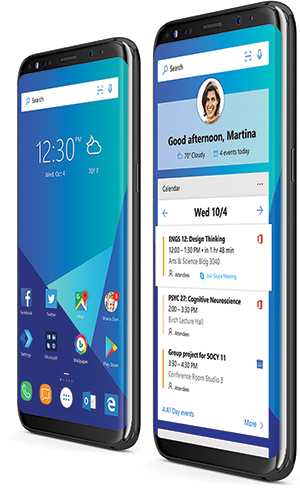 [Click on image for larger view.]
Figure 1. The Launcher is only available for Android, but lets users continue to move work from the mobile device to the PC.
[Click on image for larger view.]
Figure 1. The Launcher is only available for Android, but lets users continue to move work from the mobile device to the PC.
Edge for Android and iOS
The reason the Launcher isn't available for iOS is the fact that Apple doesn't allow third parties to take over the entire UX like Android does. But Microsoft's new Edge browser will work on both iOS and Android (see Figure 2) devices and with it, users can carry over their Favorites (bookmarks), reading lists and a feature Microsoft believes will be popular, which is called "save for later." With that feature, those viewing content on Edge from their phone opt to resume reading that material on their PCs from the point they left off.
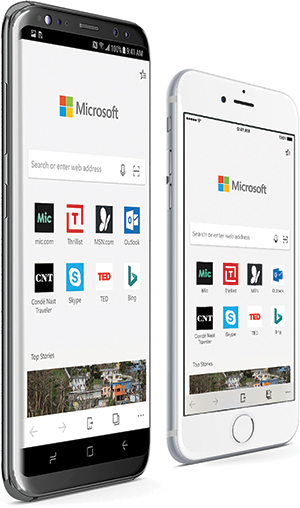 [Click on image for larger view.]
Figure 2. The Edge browser on Android (left) and iPhone (right).
[Click on image for larger view.]
Figure 2. The Edge browser on Android (left) and iPhone (right).
Mixed Reality
HoloLens is Microsoft's industrial mixed reality platform, but at $3,000, it's intended for sophisticated engineering, medical and research use cases. For home use -- mostly gaming and entertainment initially with business capabilities possible for those building to the Universal Windows Platform (UWP) -- there are now five headsets available that can connect to any PC. They include the Acer Windows Mixed Reality Headset (Figure 3), the Dell Visor, the HP Headset, the Lenovo Explorer and the Samsung HMD Odyssey (Figure 4).
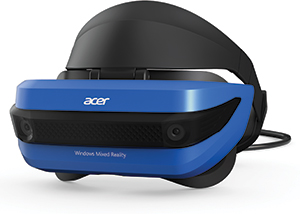 [Click on image for larger view.]
Figure 3. The Acer Windows Mixed Reality Headset has two 2.89-inch 1400x1400 LCD displays and a 105-degree field of view.
[Click on image for larger view.]
Figure 3. The Acer Windows Mixed Reality Headset has two 2.89-inch 1400x1400 LCD displays and a 105-degree field of view.
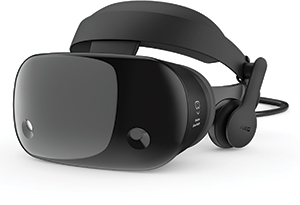 [Click on image for larger view.]
Figure 4. Samsung's HMD Odyssey provides a 110-degree field of view that appears on its dual AMOLED displays.
[Click on image for larger view.]
Figure 4. Samsung's HMD Odyssey provides a 110-degree field of view that appears on its dual AMOLED displays.
The headsets are tethered to a PC and come with handheld motion sensors. Microsoft has emphasized these units don't require the installation of cameras throughout a room. Microsoft said 20,000 UWP apps in the Windows Store now support the new mixed reality headsets, including Obduction, Dreams of Dali, Space Pirate Trainer, Superhot, Arizona Sunshine, Luna, Skyworld, Move, Free the Night, Minecraft and Fantastic Contraption.
Microsoft also recently announced that it has acquired AltspaceVR, a virtual reality-based social network that enables immersive communications and a platform used to host meetups, classes and other event types. And for those not ready to shell out $400-plus for a mixed reality headset, the Windows 10 Fall Creators Update includes the Mixed Reality Viewer. This brings mixed reality to the PC by using the system's camera, which lets viewers see them as 3-D objects.
Photo App Improvements Include Video
Also new is the way Windows 10 lets users manage and present photos. The new photo app was designed to make it easier to consolidate photos from multiple devices and cameras into OneDrive, while using new machine learning capabilities to index and search for them. According to Microsoft, the new photo app uses deep learning to recognize people, places and things, based on metadata within the file.
Once you find the photos you were looking for, it provides the option to work in effects, including 3-D objects you created or gathered. Then, by choosing the remix function, it will create a slide show based on music the data suggests might be appropriate. If you don't like the choice of music, you can choose something specific, and then create the soundtrack for your slideshow. In addition to photos, the app supports video editing.
The video editing feature is an improved version of the Movie Maker feature that Microsoft had offered in Windows 7 and brings it into the Photos app. Since Microsoft took Movie Maker out of the OS when it released Windows 8, many customers had requested the company bring video editing back to Windows, a company official said.
New Hardware
Microsoft has emphasized the fact that engineers on the Windows, Office, Surface and Xbox teams now work closely together to ensure that the experience and Fluent Design work consistently together and share common characteristics. The new Surface Book 2, which rolls out this month, is the extreme example of that effort, according to Panos Panay, Microsoft's corporate VP for devices. At an event with Windows Insiders in New York City days before the release of the Fall Creators Update, Panay previewed the new Surface Book 2 (see Figure 5). Based on the new Intel 8th Generation Core Processor platform and available with the latest Nvidia GPUs, Panay argued: "There's no computer, no laptop, no product, that's ever pushed this much computational power in this mobile form factor" (see here).
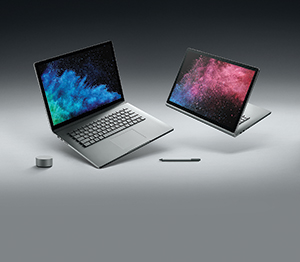 [Click on image for larger view.]
Figure 5. Microsoft claims its Surface Book 2, available in 13- and 15-inch configurations, is the most powerful Windows laptop, and is the most powerful mainstream PC released to date.
[Click on image for larger view.]
Figure 5. Microsoft claims its Surface Book 2, available in 13- and 15-inch configurations, is the most powerful Windows laptop, and is the most powerful mainstream PC released to date.
Among the PCs best-suited to exploit the new Windows 10 update features from other manufacturers are Acer's Spin 5, ASUS Zenbook Flip S UX370, Dell's XPS 13 2-in-1 system, the HP Spectre x360 13-inch system, Lenovo's Yoga 920 and the Samsung Galaxy Book 10, among 11 in all showcased by Microsoft. If you're not in a rush, all these players, among others, traditionally introduce their next crop of systems right after the holiday season at the January Consumer Electronics Show.
About the Author
Jeffrey Schwartz is editor of Redmond magazine and also covers cloud computing for Virtualization Review's Cloud Report. In addition, he writes the Channeling the Cloud column for Redmond Channel Partner. Follow him on Twitter @JeffreySchwartz.